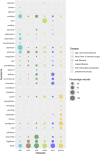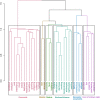Comparison of machine learning algorithms applied to symptoms to determine infectious causes of death in children: national survey of 18,000 verbal autopsies in the Million Death Study in India
- PMID: 34607591
- PMCID: PMC8488544
- DOI: 10.1186/s12889-021-11829-y
Comparison of machine learning algorithms applied to symptoms to determine infectious causes of death in children: national survey of 18,000 verbal autopsies in the Million Death Study in India
Abstract
Background: Machine learning (ML) algorithms have been successfully employed for prediction of outcomes in clinical research. In this study, we have explored the application of ML-based algorithms to predict cause of death (CoD) from verbal autopsy records available through the Million Death Study (MDS).
Methods: From MDS, 18826 unique childhood deaths at ages 1-59 months during the time period 2004-13 were selected for generating the prediction models of which over 70% of deaths were caused by six infectious diseases (pneumonia, diarrhoeal diseases, malaria, fever of unknown origin, meningitis/encephalitis, and measles). Six popular ML-based algorithms such as support vector machine, gradient boosting modeling, C5.0, artificial neural network, k-nearest neighbor, classification and regression tree were used for building the CoD prediction models.
Results: SVM algorithm was the best performer with a prediction accuracy of over 0.8. The highest accuracy was found for diarrhoeal diseases (accuracy = 0.97) and the lowest was for meningitis/encephalitis (accuracy = 0.80). The top signs/symptoms for classification of these CoDs were also extracted for each of the diseases. A combination of signs/symptoms presented by the deceased individual can effectively lead to the CoD diagnosis.
Conclusions: Overall, this study affirms that verbal autopsy tools are efficient in CoD diagnosis and that automated classification parameters captured through ML could be added to verbal autopsies to improve classification of causes of death.
Keywords: Cause of death; Child mortality; Infectious disease; Machine learning; Million Death Study; Prediction model; Verbal autopsy.
© 2021. The Author(s).
Conflict of interest statement
The authors declare that they have no competing interests.
Figures



References
Publication types
MeSH terms
LinkOut - more resources
Full Text Sources
Medical
Research Materials
Miscellaneous

